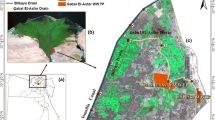Abstract
Optical dynamic properties of water have capacity to give a coherent outline of water quality, however its exactness relies on the samples gathered from water bodies. This work was performed to make utilization of remotely detected information for recognizing water quality parameters in view of optical dynamic properties of water. Airborne visible/infrared imaging spectrometer new generation (AVIRIS-NG) was guided over the Ganges River Buxer, Bihar, India gathering hyperspectral band of information. The image taken from nearly 10 km of the Ganges River with sample and line numbers 731 and 3190 respectively, having 425 spectral bands between 380 and 2510 nm wavelength with 5 nm sampling. Water test from 17 areas of Ganges River were gathered and dissected. By the utilization of ground truth information and combination of spectral band got from hyperspectral imaging, different spectral indices were readied which are valuable in evaluating chlorophyll-a, turbidity and aggregate phosphorus. The results show that the Pearson correlation between ground truth data and spectral ratio indices were stronger than the single spectral band. It is also clear that the various indices seem to associate with particular class of ground truth data. Spectral bands having wavelength 677, 702, 705, 671 and 742 nm are dominating the formation of spectral indices. The correlation and R2 for each investigated parameter were greater than 0.6 and 0.5 representing to develop a good linear model.




Similar content being viewed by others
References
Duan, W., Takara, K., He, B., Luo, P., Nover, D., Yamashiki, Y., et al. (2013). Spatial and temporal trends in estimates of nutrient and suspended sediment loads in the Ishikari river, Japan, 1985 to 2010. Science of the Total Environment, 461, 499–508.
Sloggett, D., Srokosz, M., Aiken, J., Boxall, S., et al. (1995). Operational uses of ocean colour data-perspectives for the octopus programme. Rotterdam: Balkema Publishers.
Duan, W., He, B., Takara, K., Luo, P., Nover, D., Sahu, N., et al. (2013). Spatiotemporal evaluation of water quality incidents in Japan between 1996 and 2007. Chemosphere, 93, 946–953.
Anding, D., Kauth, R., et al. (1970). Estimation of sea surface temperature from space. Remote Sensing of Environment, 1, 217–220.
Brando, V. E., Dekker, A. G., et al. (2003). Satellite hyperspectral remote sensing for estimating estuarine and coastal water quality. IEEE Transactions on Geoscience and Remote Sensing, 41, 1378–1387.
El-Din, M. S., Gaber, A., Koch, M., Ahmed, R. S., Bahgat, I., et al. (2013). Remote sensing application for water quality assessment in Lake Timsah, Suez Canal, Egypt. Journal of Remote Sensing Technology, 1, 61.
Giardino, C., Bresciani, M., Cazzaniga, I., Schenk, K., Rieger, P., Braga, F., et al. (2014). Evaluation of multi-resolution satellite sensors for assessing water quality and bottom depth of Lake Garda. Sensors, 14, 24116–24131.
Hadjimitsis, D. G., Clayton, C., et al. (2009). Assessment of temporal variations of water quality in inland water bodies using atmospheric corrected satellite remotely sensed image data. Environmental Monitoring and Assessment, 159, 281–292.
Hellweger, F., Schlosser, P., Lall, U., Weissel, J., et al. (2004). Use of satellite imagery for water quality studies in New York Harbor. Estuarine, Coastal and Shelf Science, 61, 437–448.
Kondratyev, K. Y., Pozdnyakov, D., Pettersson, L., et al. (1998). Water quality remote sensing in the visible spectrum. International Journal of Remote Sensing, 19, 957–979.
Kuo, J. T., Wu, J. H., et al. (1991). A nutrient model for a lake with time-variable volumes. Water Science Technology, 24(6), 133–139.
Kuo, J. T., Wu, J. H., Chu, W. S., et al. (1994). Water quality simulation of Te-Chi reservoir using two dimensional models. Water Science Technology, 30(2), 63–72.
Lung, W. S., et al. (1986). Assessing phosphorus control in the James River Basin. Journal of Environmental Engineering, 112(1), 44–60.
Dekker, A. G. et al. (1997). Operational tools for remote sensing of water quality: A prototype tool kit. Vrije Universiteit Amsterdam, Institute for Environmental Studies. BCRS Report 96-18.
Dekker, A. G. et al. (1993). Detection of optical water parameters for eutrophic lakes by high resolution remote sensing. Ph.D. Thesis. Free University, Amsterdam.
Gitelson, A., Garbuzov, G., Szilagyi, F., Mittenzwey, K.-H., Karnieli, K., Kaiser, A., et al. (1993). Quantitative remote sensing methods for real-time monitoring of inland waters quality. International Journal of Remote Sensing, 14, 1269–1295.
Jupp, D. L., Kirk, J. T. O., Harris, G. P., et al. (1994). Detection, identification and mapping of cyanobacteria using remote sensing to measure the optical quality of turbid inland waters. Australian Journal of Freshwater Research, 45, 801–828.
Jupp, D. L., Byrne, G., McDonald, E., Anstee, J., Harris, G., & Smith, J., et al. (1994). Monitoring optical water quality of the Hawkesbury River using airborne remote sensing. CSIRO Division of Water Resources, Consultancy Report No. 94/9.
https://www.worldlistmania.com/top-10-largest-rivers-world/.
CPCB. (2008). Guidelines for water quality monitoring (2007–2008). Central Pollution Control Board CPCB. Ministry of Environment. For. MINARS/27/2007-08. 06-15.
http://bspcb.bih.nic.in/River%20Ganga%20and%20its%20Tributaries%20%20(16-17).pdf.
Shafique, N. A., Fulk, F., Autrey, B. C., & Flotemersch, J., et.al. (2003). Hyperspectral remote sensing of water quality parameters for large rivers in the Ohio River basin. Research Gate. 216–221. https://www.tucson.ars.ag.gov/icrw/Proceedings/Shafique.pdf.
Acknowledgements
Authors are grateful to Director CSIR-CSIO, Chandigarh India for granting permission to undertake the presented work, and Space Application Center (SAC), Ahmedabad, India for financial support under Grant GAP0365 for the presented findings.
Author information
Authors and Affiliations
Corresponding author
Rights and permissions
About this article
Cite this article
Bansod, B., Singh, R. & Thakur, R. Analysis of water quality parameters by hyperspectral imaging in Ganges River. Spat. Inf. Res. 26, 203–211 (2018). https://doi.org/10.1007/s41324-018-0164-4
Received:
Revised:
Accepted:
Published:
Issue Date:
DOI: https://doi.org/10.1007/s41324-018-0164-4




